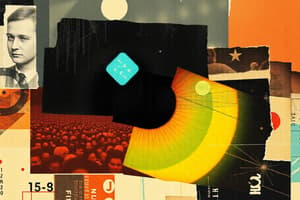Podcast
Questions and Answers
What is the typical value range for contact lenses compared to spectacles?
What is the typical value range for contact lenses compared to spectacles?
- -0.75 to -1.0 Dioptres below spectacles
- -0.5 to -0.75 Dioptres below spectacles
- -0.25 to -0.5 Dioptres below spectacles (correct)
- Equal to the value of spectacles
How many optotypes must an applicant correctly identify to rate their visual acuity as seen?
How many optotypes must an applicant correctly identify to rate their visual acuity as seen?
- 5
- 3
- 8
- 6 (correct)
What is the required binocular near visual acuity for Class 2 at a distance of 30-50 cm?
What is the required binocular near visual acuity for Class 2 at a distance of 30-50 cm?
- N3 (0.9)
- N5 (0.7) (correct)
- N4 (0.8)
- N6 (0.6)
In the context of visual acuity exams, what does the acronym ICAO refer to?
In the context of visual acuity exams, what does the acronym ICAO refer to?
What is the maximum astigmatism that can be corrected with regular contact lenses?
What is the maximum astigmatism that can be corrected with regular contact lenses?
What condition is characterized by the eye being too short and the focus laying behind the retina?
What condition is characterized by the eye being too short and the focus laying behind the retina?
Which method is NOT commonly used for testing color vision?
Which method is NOT commonly used for testing color vision?
At what near point measurement is accommodation around 10 diopters expected for a 26-year-old?
At what near point measurement is accommodation around 10 diopters expected for a 26-year-old?
What should be considered when assessing visual acuity for aviation duties?
What should be considered when assessing visual acuity for aviation duties?
Which condition results in difficulty seeing objects clearly at a distance?
Which condition results in difficulty seeing objects clearly at a distance?
What does orthophoria indicate regarding eye axes?
What does orthophoria indicate regarding eye axes?
Which statement about stereo vision is true?
Which statement about stereo vision is true?
What is the significance of binocular vision as indicated by stereotests?
What is the significance of binocular vision as indicated by stereotests?
Which examination is deemed necessary if there is any decrease in visual acuity?
Which examination is deemed necessary if there is any decrease in visual acuity?
What should be included in a comprehensive eye examination?
What should be included in a comprehensive eye examination?
In a situation of vision distance limitation (VDL), what is required?
In a situation of vision distance limitation (VDL), what is required?
What is the purpose of the papilla in funduscopy?
What is the purpose of the papilla in funduscopy?
When must contact lenses be declared appropriate for use?
When must contact lenses be declared appropriate for use?
What condition must be checked during a routine eye examination?
What condition must be checked during a routine eye examination?
What defines heterophoria?
What defines heterophoria?
Flashcards are hidden until you start studying
Study Notes
Overview of the Visual System and Colour Vision
- Critical for Aeromedical Examiners (AMEs) to understand eye anatomy, visual acuity assessment, and related ophthalmological examination techniques.
- Essential ability to determine visual fitness related to aviation duties, including colour vision and ocular health.
Eye Anatomy and Vision Issues
- Emmetropia: Normal vision where light focuses directly on the retina.
- Hyperopia (Farsightedness): Eye is too short; corrective lenses are converging.
- Myopia (Nearsightedness): Eye is too long; corrective lenses are diverging.
- Astigmatism: Distorted vision due to irregular curvature of the cornea or lens.
- Presbyopia: Age-related difficulty in focusing on near objects due to loss of elasticity in the lens.
Visual Acuity and Examination Procedures
- Testing Methods: Includes direct vision charts like Landoltring, near visual acuity charts, and certification tests for monocular and binocular vision.
- Visual Acuity Standards: Class 2 requirements mandate monocular acuity > 0.5 and binocular acuity > 0.7.
- Assessment of near, intermediate, and distant vision is crucial at revalidation for Class 2.
Colour Vision Testing
- Crucial for pilots; methods include Ishihara plates, lantern tests, and anomaloscopy.
- Colour deficiency affects approximately 8% of males, often related to red/green vision.
- First 15 Ishihara plates must be identified correctly; failures lead to further evaluations and limitations.
Accommodation and Convergence
- Accommodation: Ability of the eye to adjust focus on near objects; changes with age and significantly decreases after 40 years.
- Convergence: Necessary for proper ocular alignment and depth perception during close work.
Spectacle and Contact Lens Requirements
- Prescription for spectacles may differ from contact lenses; contact lenses typically require adjustment of diopters by -0.25 to -0.5 compared to glasses.
- Regulations stipulate wearing corrective lenses during flight, with a requirement for a spare pair.
Limitations and Medical Flight Tests
- Visual limitations (e.g., VDL, VNL, VML) govern standards for aviation duties based on corrective measures and visual acuity.
- Medical flight tests evaluate the ability to handle aircraft controls in normal and emergency conditions, ensuring safety during operation.
Comprehensive Eye Examination Steps
- Includes history taking, visual acuity assessments (near, intermediate, distant), external eye examination, and fundoscopy for underlying conditions.
- Regular examinations are mandated if there is any noticeable decrease in vision or upon the occurrence of eye-related issues.
Amblyopia and Monocular Requirements
- Amblyopia, a developmental condition resulting in poor vision in one eye, necessitates specific standards of visual acuity for pilots.
- Monocular pilots must have a better eye vision corrected or uncorrected > 1.0, with normal visual fields.
Key Takeaways for AME
- Understanding and effectively applying visual examination protocols and standards is vital for certifying pilots.
- Awareness of various visual requirements and limitations is essential to ensure pilots meet safety regulations while operating aircraft.
Studying That Suits You
Use AI to generate personalized quizzes and flashcards to suit your learning preferences.




